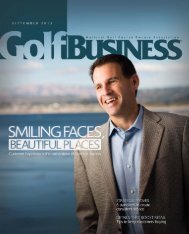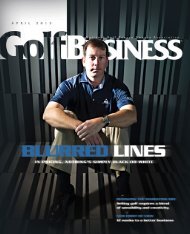Community - GolfBusiness
Community - GolfBusiness
Community - GolfBusiness
You also want an ePaper? Increase the reach of your titles
YUMPU automatically turns print PDFs into web optimized ePapers that Google loves.
Golf Industry<br />
Calendar<br />
April 16<br />
National Golf Day<br />
Washington, DC<br />
www.wearegolf.org<br />
April 21-25<br />
American Society of Golf<br />
Course Architects Annual Meeting<br />
Reynolds Plantation<br />
Greensboro, Georgia<br />
www.asgca.org<br />
Throughout May<br />
Welcome to Golf Month<br />
Nationwide<br />
Playgolfamerica.com<br />
Throughout July<br />
Family Golf Month<br />
Nationwide<br />
Playgolfamerica.com<br />
July 8-14<br />
Take Your Daughter<br />
to the Course Week<br />
Nationwide<br />
Playgolfamerica.com<br />
August 22-24<br />
PGA FALL EXPO<br />
Las Vegas, NV<br />
August 30 - September 2<br />
Patriot Golf Day<br />
Nationwide<br />
www.playgolfamerica.com<br />
FOR MORE EVENTS, INCLUDING NGCOA<br />
CHAPTER HAPPENINGS, VISIT WWW.NGCOA.ORG<br />
Going Green On the Greens<br />
Operators of The Vineyard have found<br />
ways to go green on and off the course.<br />
lthough the organic movement has<br />
Atouched nearly every facet of modern<br />
life, it’s been relatively slow (ironically)<br />
in gaining widespread traction in the<br />
golf industry. But one course on Martha’s<br />
Vineyard is showing how golf courses can<br />
go green—and still operate in the black.<br />
The Vineyard, which opened in<br />
2002, was met with fierce opposition<br />
from locals when developers unveiled<br />
plans for the private club located on<br />
the island’s eastern tip. To allay locals’<br />
concerns about the course’s impact<br />
on the fragile aquifer, the investors<br />
agreed to a series of strict restrictions<br />
that included limitations on water use<br />
(150,000 gallons a day) and bans on<br />
chemical or synthetic products.<br />
Superintendent Jeff Carlson was<br />
charged with the unenviable task of<br />
maintaining an elite-level private course<br />
under these aggressive constraints.<br />
Though he had worked at facilities in<br />
New England with strict environmental<br />
controls, the veteran turf care manager<br />
admits he was “still pretty nervous”<br />
about the challenge he faced at The<br />
Vineyard. The early years, no doubt,<br />
proved difficult.<br />
“We had a lot of issues with dollar<br />
spot in the beginning,” Carlson recounts.<br />
“I actually thought it was going<br />
to wipe out the course.”<br />
But over the last<br />
decade, Carlson and his<br />
crew have adapted to their<br />
circumstances. They’ve<br />
had to alter nearly every<br />
cultural practice, from<br />
aeration to irrigation,<br />
even nitrogen application.<br />
Meanwhile, the industry<br />
caught up as well, supplying<br />
organic alternatives to<br />
products he had been prohibited<br />
from using. And<br />
though most of the credit<br />
goes to his hardworking<br />
crew, Carlson says natural selection<br />
is at work, too. “The grass that’s left is<br />
the stuff that’s hardy enough to survive<br />
in these conditions,” he notes.<br />
Courses looking to go organic to cut<br />
expenses will be disappointed; many<br />
of the organic turf care solutions are<br />
expensive and labor-intensive. “I could<br />
have a full-time crew just doing weed<br />
control,” Carlson quips.<br />
Carlson does have advice for course<br />
operators looking to lessen their environmental<br />
impact: don’t focus on tees and<br />
greens, as they’re only 5 percent to 10<br />
percent of a course’s turf. Instead, start<br />
with an organic management program<br />
on large areas like the rough or fairways.<br />
Moreover, the graduate of Drew<br />
University stresses the importance of<br />
communication. “Setting expectations is<br />
key,” he says. “Don’t hide in your office—<br />
get out there and talk to the members,<br />
the greens committee, whoever it is.”<br />
Carlson must be doing something<br />
right. The course has hosted President<br />
Obama on a number of occasions. That<br />
presidential endorsement, and the approval<br />
of the club’s demanding members,<br />
makes all of Carlson’s hard work<br />
worthwhile. “It’s even more rewarding<br />
knowing we’re doing it without harming<br />
the earth.” —Kyle Darbyson<br />
44 GOLFBUSINESS March 2013




